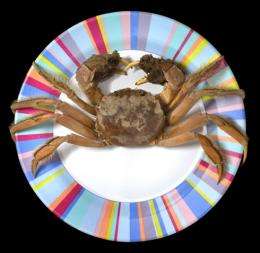Help scientists record invasion of Chinese mitten crabs

Its name might sound cuddly but the Chinese mitten crab is one of the worlds worst invasive species and scientists need help recording sightings in the UK.
Scientists from the Natural History Museum, University of Newcastle, Royal Holloway University of London, The Countryside Council for Wales and the Marine Biological Association, want people to take part in the Mitten Crab Recording Project, to find out the true distribution of these crustaceans in rivers and waterways in England and Wales.
Chinese mitten crabs are easy to spot with their large furry front claws and they are about the size of a plate.
In the UK they cause immense economic and ecological damage, to unprotected river banks, blocking water systems, damaging fishing gear and competing with native species for food and habitat.
They are in the Global Invasive Species Database list of the world's worst 100 invasive alien species.
Anglers, waterway workers, boating enthusiasts or nature lovers are most likely to come across these crustaceans, but anyone can record a sighting online or or by telephone, email or text, details of which are at www.mittencrabs.org.uk .
Chinese mitten crabs are originally from Asia and native to the Province of Fukien, China. They first appeared in northern Europe when they were accidentally introduced to Germany in 1912 from ships' ballast water.
The first British record of a Chinese mitten crab was from the River Thames catchment in Chelsea in 1935. The Thames population dramatically increased at the end of the 1980s and they are now currently found throughout Europe.
The Chinese mitten crabs are now established in the rivers Thames, Medway, Ouse Washes, Humber and the Dee Estuary.
Scientists are particularly interested in sightings in the Thames west of Windsor to beyond Reading; Tyne, Tees and Wear in the North East; Dee and Merseyside and from the Severn Estuary to the Isle of Wight in the South West. However records from other places are also welcome.
The scientific name for the Chinese mitten crab is Eriocheir sinensis. This name is from the Greek, meaning ‘wool hand of the Chinese’ in reference to soft bristles covering their large claws.
They are catadromous, which means they spend most of their life in freshwater, but must return to the sea to breed.
Museum scientists have been studying Chinese mitten crabs for years and in February 2009 announced research that showed they would be safe to eat and exploit commercially.
Provided by American Museum of Natural History



















